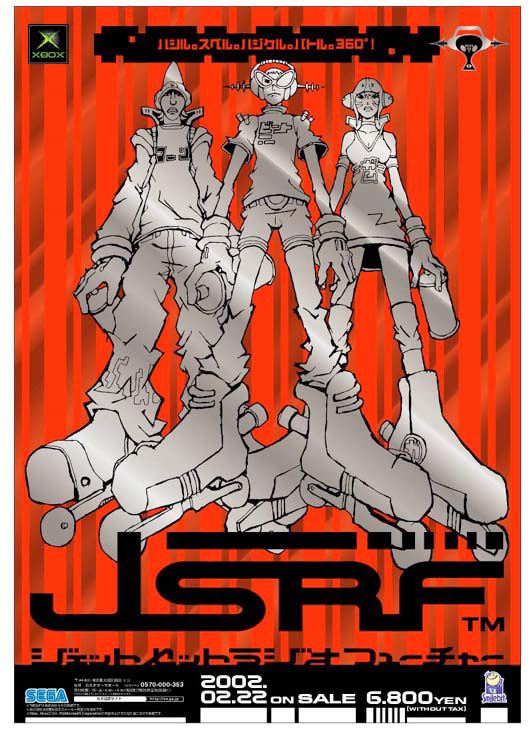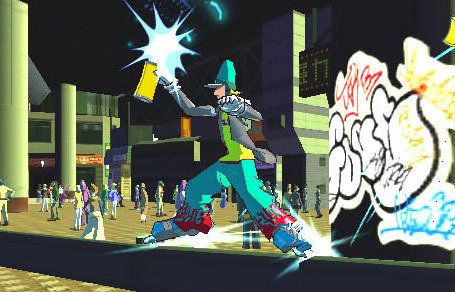Last updated on March 4, 2013
TL; DR – Jet Set Radio Future combines the trick style system of the Tony Hawk Skateboarding series with a healthy dose of platforming (huh?) and graffiti spraying. It’s got a unique style and an awesome soundtrack to boot, but little flaws keep it from total greatness; the repetitive mission structure and loose controls don’t help either. Whether you will like Jet Set Radio Future mostly depends on your ability to overlook problems for presentation.
Jet Set Radio Future combines the trick style system of the Tony Hawk Skateboarding series with a healthy dose of platforming (huh?) and graffiti spraying (really?). Well, it’s somewhat of a misnomer to say that JSRF bears great resemblance to Tony Hawk Pro Skater; rather, it bears family resemblance. If Tony Hawk represents the American version, than wouldn’t you expect the Japanese take on the genre to be absolute crazy and filled with a nonsensical plot about rebellion against a fascist regime? They can only be defeated with the art of…putting graffiti on everything. One can imagine why this game (and its predecessor for the Dreamcast) didn’t sell particularly well.
Jet Set Radio, according to the game’s lore, is a pirate radio station located in Tokyo that airs illegal broadcasts. At the moment the game starts, Tokyo is controlled by the Rokkaku Group, an evil syndicate that seems to control not only the government but the police force and every other aspects of society. It is at these darkest of times that DJ Big Gouji appears to “bring the fresh beats to the streets” and restart Jet Set Radio to form a revolution of sorts. Somehow, by spraying the town with graffiti, rebellion against the corporation will be sparked and the revolutionaries will win, not by violence, but by spraying graffiti. You, as one of the GG’s must bring an end to the evil Rokkaku regime through…graffiti and grinding both of which contribute to point totals. Obviously, this wouldn’t work in the real world, but here it does. Your spray cans will take down policemen, helicopter, fighter jets, trains, and basically anything else you can imagine. It’s truly bizarre, but a great part of Jet Set Radio Future’s charm. It is a world completely different from our own, a fantasy realm you can get sucked into rather easily. With its distinct Japanese sensibilities, the quirky story, though fun, is pretty irrelevant to the rest of the game.
And yes, there’s a playable character named “Corn”. Why? Who knows.
However, JSRF isn’t just about point totals and stringing tricks together. Some sections are scored, but they are few and far between; much of your time is spent using graffiti on everything within a particular area, usually with a time limit. You’ll find all the grinding and tricks you want, but the game strikes me as more a platformer on wheels with a bit of combat for flavor. These disparate elements seem like they wouldn’t work within the context of one game, but Jet Set Radio Future combines these factors rather well, when it’s not trying to hamper itself.
As note previously, the game has latched onto the Tony Hawk series to a degree – only this time, we have rollerblades! Not that this changes anything. Unlike Tony Hawk, grinding makes you gain speed regardless of whether you’re going up or down. It’s magical, almost, how a stylish rebel with rollerskates can grind against the natural forces of gravity. As such, grinding is the focus here, with incredibly long strings of rails only separated by well timed jumps. The momentum of the speed of your grind also affects your jump trajectory, making it imperative that you time you leaps with precision. A lot of grinding gets combined with lots of tagging (graffiti spray), so a judicious pressing of the R trigger will also be required fairly frequently.
Grinding, though, can sometimes make sections a chore. If you’ve ever played a game that required the player to climb an incredibly tall building, only to fall and start from the bottom, certain segments of JSRF encapsulate this perfectly. You can tag every one of the signs along the way, miss one during a failed jump to the beginning of a stage, and then have to climb your way back up. The game uses a checkpoint system, but that’s only when you die and never during a graffiti objective. Hence, a lack of accuracy can mean a heck of a lot of backtracking. One could frame this as punishment for your mistakes, but when you’ve tagged 49/50 areas and you’re just missing one in an incovenient place, it can annoy pretty quickly. Did I mention you need to collect spray cans to tag anything, and you can waste cans? Have fun wandering around an area to find more!
Finding items becomes difficult because the map or “areas” are fairly large. The Tokyo of the JRSF universe, actually, is pretty expansive; there’s people walking everywhere, police officers who want to beat you, and all manner of different secrets to collect. One of my personal favorites is a stage composed completely of telephone/electric wires – it almost gives a sense of vertigo as you jump from wire to wire. Though the design makes no logical sense from a realistic standpoint, JSRF doesn’t have ambition to be anything more than a stylish video game, so the technique works. As well, there are challenges requiring you to pick up flags, tag other skaters and giant killer robots, or race other people. If you were tagging everything, it’d get boring, but tagging a moving target? Sign me up! It’s rather hilarious watching police covered in graffiti (that’s “combat” in a nutshell). Regardless of the fact that this part of the game is in no way revolutionary, the graffiti tagging remains fun throughout, and the satisfaction of completing the challenges presented is well placed – this game is not that easy.
However, the difficulty comes more from the loose controls than it does from the difficulty of the challenges. In my experience, stopping your character can be a hopeless effort, and you may fly off platforms often. I looked through the manual and guides for a way to stop on a dime and couldn’t find it. Any built-up momentum can ruin your fun quickly. This problem becomes apparent especially in the Skyscraper District, where the entire mission consists of flying from the roofs of skyscrapers. Your timing and direction must be precise when making these jumps. Unlike most stages, a fall results in a bottomless pit, and that means returning to the beginning of a segment. It’s similar to the problem with grinding, except you have a health meter in this game – fall into these pits too many times and you die.
Even without the threat of player death, grinding isn’t foolproof. Grinding, though reminiscent of EA’s recent skate game, tends to be rather difficult to stop. There’s no way to stop grinding except slowing down or jumping off the rail, but many situations have rails so close that you will just end up on another rail – sometimes incredibly frustrating. I also found myself going to the map screen more than I would have liked – some of the graffiti tags are very hard to find by yourself, and you may pull your hair out trying to find that one item you need to finish the mission off. The camera harms more than help; you can recenter it behind the character, but the use of this is limited; timing split-second decisions becomes all the more difficult where you don’t know where you are jumping, or where the developers want you to jump.
From that description, you may not want to play JSRF at all. However, these issues aren’r game-breakers by any means. I would say the vast majority of my deaths were my fault, and the game doesn’t pull its punches on these challenges. As it’s not a long game (I’d say about 6-8 hours or so, if you’re rushing), it’s worth a try, at the very least. Even so, the game really nails the presentational elements. The soundtrack, honestly, is AMAZING. Hideki Naganuma has an incredibly particular style that fits the game like a glove. An eclectic mix of underground Japanese indie-rock, Latch Brothers remixes and some really unique genre mishmashes, it is some of the most intensely catchy and fitting music for a game I’ve ever heard. You owe it to yourself to keep playing just to hear the soundtrack, and buying the soundtrack wouldn’t be a bad idea either. It truly fits the action, the style, and the mood of the game, something few soundtracks with licensed music have accomplished. There’s only about 30 songs total, but each one fits every action you do in the game. Combined with the cel-shaded and hyperstylized graphics, it’s quite an experience overall.
Where did the idea for this game come from? Probably the same place where all creativity comes from: God. It’s frankly whacky and out there, but was building the Ark of the Covenant and the Tabernacle in the middle of a desert any weirder? Check out Exodus 35 and 36, where it basically says that God gives them the tools and skills to build everything:
30 Then Moses said to the sons of Israel, “See, the Lord has called by name Bezalel the son of Uri, the son of Hur, of the tribe of Judah. 31 And He has filled him with the Spirit of God, in wisdom, in understanding and in knowledge and in all craftsmanship; 32 to make designs for working in gold and in silver and in bronze, 33 and in the cutting of stones for settings and in the carving of wood, so as to perform in every inventive work. 34 He also has put in his heart to teach, both he and Oholiab, the son of Ahisamach, of the tribe of Dan. 35 He has filled them with skill to perform every work of an engraver and of a designer and of an embroiderer, in blue and in purple and in scarlet material, and in fine linen, and of a weaver, as performers of every work and makers of designs.
36 “Now Bezalel and Oholiab, and every skillful person in whom the Lord has put skill and understanding to know how to perform all the work [c]in the construction of the sanctuary, shall perform in accordance with all that the Lordhas commanded.”
It doesn’t seem a stretch to say Christian should be the most creative people on the planet; anyone who sees the world from above, rather than below, should be able to see the world in perspective and produce such work. That’s what I see in JSRF, anyway: there’s an opportunity for endless creativity.
Whether you will like Jet Set Radio Future mostly depends on your ability to overlook problems for presentation. It’s a mediocre experience overall, unfortunately. Sure, it is lots of fun and even the repetitive nature of the tasks are made fun by the music, but the game is pretty much the same through and through. This is rectificed somewhat by the short length, but the design issues may frustrate you if you have a short attention span. For the price, however, and its backward compatibility with the Xbox 360, you really have no excuse not to try it out at least.. There’s slowdown that wasn’t present on the original Xbox, but overall it still plays fine. Those with a penchant for Tony Hawk and the avant-garde would do well to check it out.
To understand the scoring system, see our Review Policy.


